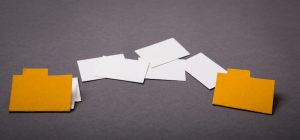
- A young woman holding a delete key of a keyboard
2. Take immediate action on files you encounter

- Found a half-finished logo? Wrap it up and send it off.
- Almost done with a piece of code? Finish it.
- Have a group of files you’re not sure you need anymore? Go through them, decide, and delete if necessary.
3. Consolidate files when possible
- For text, simply copy/paste related content from multiple files into one main text file.
- For visual designs, you can copy/paste different elements and variations into one main graphic file.

Use the support for layering, labeling, and grouping provided by all graphics programs, major and minor. One graphics file may include many logos or various components of a larger design.
4. Have as few folders as possible
Don’t over-categorize your work into dozens of different categories. Use simple categories like “logos” and “websites” instead of a “folders” subfolder with dozens of subfolders. If you choose, you may create separate folders for each project and store all files relevant to that project in those folders.
Why do this? Two reasons:
- No indecision paralysis: is the file a logo, website stuff, or part of a project? Just throw it in the respective folder and be done with it.
- Anti-too-many-files filter: when you see the folder filling up with too many files, you’ll be more inclined to delete old and unnecessary ones. Similar to seeing too much stuff in your room, rather than hiding it in drawers and other rooms.

It’s best to keep folder names and categories general. More categories can be created with more particular naming of folders. The addition of extra folders means you’ll have to prioritize where to save the file.
The chances aWhy not just employ a system of tags instead? If that’s the case, you probably don’t need any more folders. That makes sense in concept, but in practice it will lead you to produce and store far too many files.
high that it doesn’t fit neatly into any of them, so you’ll have to choose one at random. The next time you need to sort any files, you may simply recall the folder into which you put one that was quite similar. And it doesn’t help that you have no idea which folder each file actually belongs to.
Here’s what will happen:
- You tag your initial files, feeling good that you’ll be able to easily find them later by searching via tags.
- You become liberal with tags by creating too many tags that are too specific – this is due to indecision paralysis since you couldn’t choose between two tags and decided to create a new one specifically for that one file.
- You end up having too many tags which become overwhelming to find stuff with.
- What’s worse is since you didn’t feel the need to keep your file count low, you now have more files than if they were constantly visible in a general folder you looked in.
5. Ditch auto-organizing features
The enemy of file management is automatic file organization tools (like iTunes’ auto-rename and sort function, but for all your files). They promote a relaxed attitude toward creating and saving new files. While this may work great at first, it quickly becomes untenable as more and more files are added.
Is it not better to just remove unused or outdated files from storage? Using the auto-organize function will make it less tempting to remove. Like Google’s “never delete, only search” option in Gmail. Searching emails is simple since there is just one sort of material (text), but searching files is difficult.
There is no easy method to look for certain words or phrases inside the text, especially for multimedia files. So, you will be limited to working with filenames and perhaps a meta description. There will be too many files if you do that.
Instead than relying on automated filing systems, take full responsibility for all of your work by manually cataloging all new documents. At the very least, you’ll be reminded of its existence and given some attention, making you more careful about the files you keep on your computer. You’ll have a better idea of when your file collection has grown out of hand and when you need to start purging aggressively.
Conclusion;
I sincerely hope that these 5 tips weren’t just some kind of productivity porn: stuff to read in order to avoid doing the kind of work that actually brings you the outcomes you want in life. Instead, they were meant to be practical steps you can take right away to ensure that your digital and design files remain under control.
Nobody enjoys the process of sorting and managing digital and artistic documents. You may prevent having to resort to such drastic measure by adopting the following five behaviors. The most crucial step in forming any new routine is to actually begin doing whatever it is you want to accomplish.